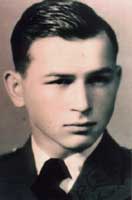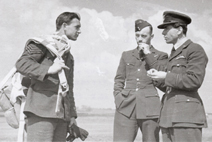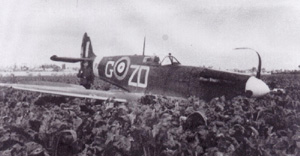Rudolf Ptacek (1918 - 1942). |
| Rudolf Ptacek was born 19 April 1918 in Kostelec nad Orlici in the Czech part of the country that would soon become Czechoslovakia. His father owned a leather shop but died while Rudolf was still in elementary school. |

|
|
| On 1 October 1936 Rudolf left his studies at a school for confectioners to enter the pilot school in Prostejov, Czechia where he graduated in May 1938 as a letec-polni pilot. When the Germans invaded his country on 15 March 1939, like many others he escaped to Poland by train, where he was posted to the Czechoslovakian camp at Bronowice near Krakow. He left Poland 25 July on the Swedish passenger ship "Castelholm" and arrived at Boulogne-sur-Mer 1 August 1939. |
This photograph of Rudolf Ptacek at his graduation in 1938 is courtesy of Mark Gaskell |
| In January 1940 caporal 6744 Rudolf Ptacek was based in Chartres where he trained on Morane-Saulnier MS-230s. On 13 May 1940, caporal-chef Ptacek was a member of the defense patrol of Chartres air base. This unit comprised 16 Czech pilots, including Frantisek Fajtl (who was himself shot down in May 1942 and successfully evaded) and equipped with Morane-Saulnier MS-406s and Bloch 151s. |
In his 1991 book 'Letal jsem s 313' General Frantisek Fajtl recalls his memories of Ptacek ...
|
"Ptacek was a very good pilot and he loved Czech history. He was able to relate about it and he was big fan of the Czech king Jan Lucembursky. We both served together in France at the airbase in Chartres. After retraining on the Morane MS-406 fighter plane, we were posted as operational pilots for the defence of the airbase at Chartres. |
On the 3rd June 1940 a bomber raid was announced as the first bombs exploded. The three pilots at readiness had to jump into their planes, the leader of these planes was another Czech, Vaclav Bergman. Ptacek took off without parachute and helmet because he was making a physical necessity (he was on the toilet). By a miracle they found the enemy aircraft immediately and began to attack them. There were 15 twin engine Dornier Do 17 bombers in a big group, which made terrible defence fire. Planes of both Czechs were hit in many places. Bergman's Morane had 30 hits and Ptacek was wounded on his arm, he lost his finger. When his friends had offered their regrets to him after landing he said: "Don't worry, it was just a very little finger", he then hurried to the doctor to get treatment for his injury. |
I liked to hear Ptacek talking when we were sitting in front of the hangar at Chartres and we were waiting for orders. He would dip into our history and would remind us of big acts from our history in effort to do more of them. He was … a likeable and good looking non-officer, who was a modest and honest fighter of our just war. I didn't see in his face any suggestion of the drama, which would afflict him in near future." |
After the collapse of France and still suffering from his wounds, Ptacek made his way to St Jean de Luz and escaped to England by sea, arriving in Plymouth on 26 June 1940. He joined the Royal Air Force on 25 July 1940 as 787434 Aircraftman 2nd Class and after a time at Cosford was promoted to Sergeant and on 26 September posted to No 6 Operational Training Unit at Sutton Bridge for a Hurricane conversion course. On 4 October 1940 Sergeant Ptacek was posted to 43 Squadron based at Usworth where he took part in the last dogfights of the Battle of Britain. |
On 23 November 1940, Ptacek was posted to 615 Sqn in Northolt, another Hurricane Squadron. On 11 June 1941 he was posted to 313 (Czech) Sqn at Catterick to became one of its founder members along with his friend Fajtl, flying Spitfires Mk Is but on 5 July 1941 he was transferred to 222 Sqn (Natal) at Manston, and later Southend, flying Spitfire Mk IIs. |
 |
On 18 August 1941, 222 (Natal) Sqn moved to North Weald. The day after, 12 of the unit's Spitfires took off at 5:40 pm (English time) to take part in CIRCUS 82. At about 6:25 pm (English time) flying aboard Spitfire Mk IIB serial number P8244 "WIGAN AND DISTRICT", Ptacek claimed a Bf-109 destroyed east of St Omer before being shot down by Oberleutnant Johannes Schimd of Stab/JG 26, at 7:55 pm (German time) |
| This photograph - courtesy of Jaroslav Popelka - shows Ptacek (left) with
F/O O Richter and F/O Frantisek Fajtl at 313 (Czech) Squadron |
On 18 August 1941, 222 (Natal) Sqn moved to North Weald. The day after, 12 of the unit's Spitfires took off at 5:40 pm (English time) to take part in CIRCUS 82. At about 6:25 pm (English time) flying aboard Spitfire Mk IIB serial number P8244 "WIGAN AND DISTRICT", Ptacek claimed a Bf-109 destroyed east of St Omer before being shot down by Oberleutnant Johannes Schimd of Stab/JG 26, at 7:55 pm (German time) |
 |
The "Wigan and District Spitfire Appeal" collected donations amounting to £7,886, 5 shillings and 8 pence and Supermarine Spitfire Mk IIB serial number P8244 was given the name "WIGAN AND DISTRICT". Built in the Castle Bromwich factory of Vickers-Armstrong under a contract dated 12 March 1939 for 1000 Spitfire IIs, she was issued to No 24 Maintenance Unit at Ternhill on 30 March 1941. On 25 May 1941, she was taken in charge by No 222 (Natal) Sqn, based in North Weald where she received the fuselage code ZD-G. Spitfire "WIGAN AND DISTRICT" was struck off charge as missing 19 August 1941. |
This photograph of Rudolf Ptacek's "Wigan & District" Spitfire crashed in a field near St Omer is courtesy of Joss Leclercq |
| Rudolf Ptacek successfully evaded capture, was put in touch with the 'Organisation' and returned to the UK by what later became known as the Pat O'Leary escape line - for details see the Conscript Heroes page. |
| On 8 January 1942, three days after his return from France, Sgt Ptacek was posted to 602 (City of Glasgow) Sqn, based in Kenley and on 3 February was promoted to Warrant Officer. On 28 March 1942 W/O Rudolf Ptacek was flying a 602 Sqn Spitfire VB on a RODEO fighter sweep over enemy territory when he was reported missing, presumed shot down near Calais. His name is inscribed on Panel 73 of the Runnymede Memorial. |
| CIRCUS 81 |
| Two CIRCUS (bomber escort) missions took place on 19 August 1941. CIRCUS 81 was flown in the late morning during an abortive raid against Gosnay power station. It was also known as OPERATION LEG because it was during this mission that a container with replacement artificial legs for W/C Douglas Bader was dropped at St Omer. JG 26 lost three pilots during this attack while the RAF lost four pilots and seven Spitfires. |
| CIRCUS 82 |
| CIRCUS 82 was detected at 19:08 pm German time. Six Blenheims from 107 Sqn were sent to bomb Hazebrouck power station. A report by Mr Tripier, 'Inspecteur du Travail', states that the bombardment took place at 1930 hours. There was no damage done to industrial or commercial buildings, but 3 houses were completely destroyed while 31 others were rendered totally unusable. There were no victims either in the population or in the industrial buildings. Eight RAF fighters were lost on the homeward leg of this operation. Two pilots were killed, two were captured and two managed to get back whilst Sgts Rudolf Ptacek and Adolf Pietrasiak (308 Sqn) both evaded in France and returned to the UK together. |
| Postscript:On 6 November 1941, Johannes Schmid was killed while flying too low over the spot where his 45th victim had fallen in the Channel. The wingtip of his plane touched the water and the plane crashed into the sea where she sank immediately. After his promotion to Hauptmann, he had become Staffelkapitäne of the 8 Staffel of JG 26, and had earned the Knight's Cross of the Iron Cross following his 24th victory - Ptacek ! |
| Almost all of the information about Rudolf Ptacek - particularly his early career and the details of his WIGAN AND DISTRICT Spitfire - comes from Mark Gaskell and Joss Leclercq |
|
|
|

